<a download> and Content-Disposition
前言
身為一位前端工程師,某天在 code review 的時候,發現同事寫了一段讓我很好奇的程式碼
libs/ui/src/file-link/index.stories.tsx
export const Url: Story = {
// Note: we use a base64 data URL here to avoid CORS issues in Storybook.
args: {
file: {
name: "example-image.jpg",
// url: 'https://randomuser.me/api/portraits/men/71.jpg',
url: "data:image/jpeg;base64,...",
},
},
};
經過一番詢問 & 考證,得知 MDN 在 <a download> 的區塊寫了一段 Note:
download only works for same-origin URLs, or the blob: and data: schemes.
在前端打滾了 4 ~ 5 年的的我,竟然不知道瀏覽器在 <a download> 有這個安全性機制;我第一時間想到的是 Content-Disposition,但之前並沒有深入研究 Content-Disposition 跟 <a download> 的愛恨糾葛,所以就趁這個機會來實測看看吧!
cross-origin + no CD + <a download>
這是我同事遇到的情況 => 用 <a download> 下載一張 cross-origin 的圖片;沒有設定 Content-Disposition 的情況,預設值是 inline
寫個 NodeJS http 的 PoC
import httpServer from "../httpServer";
httpServer.on("request", function requestListener(req, res) {
if (req.url === "/") {
res.setHeader("Content-Type", "text/html");
res.end(
'<a href="https://randomuser.me/api/portraits/men/71.jpg" download>download</a>',
);
return;
}
});
Chrome V142 實測後,確實沒有下載,而是直接原頁導轉
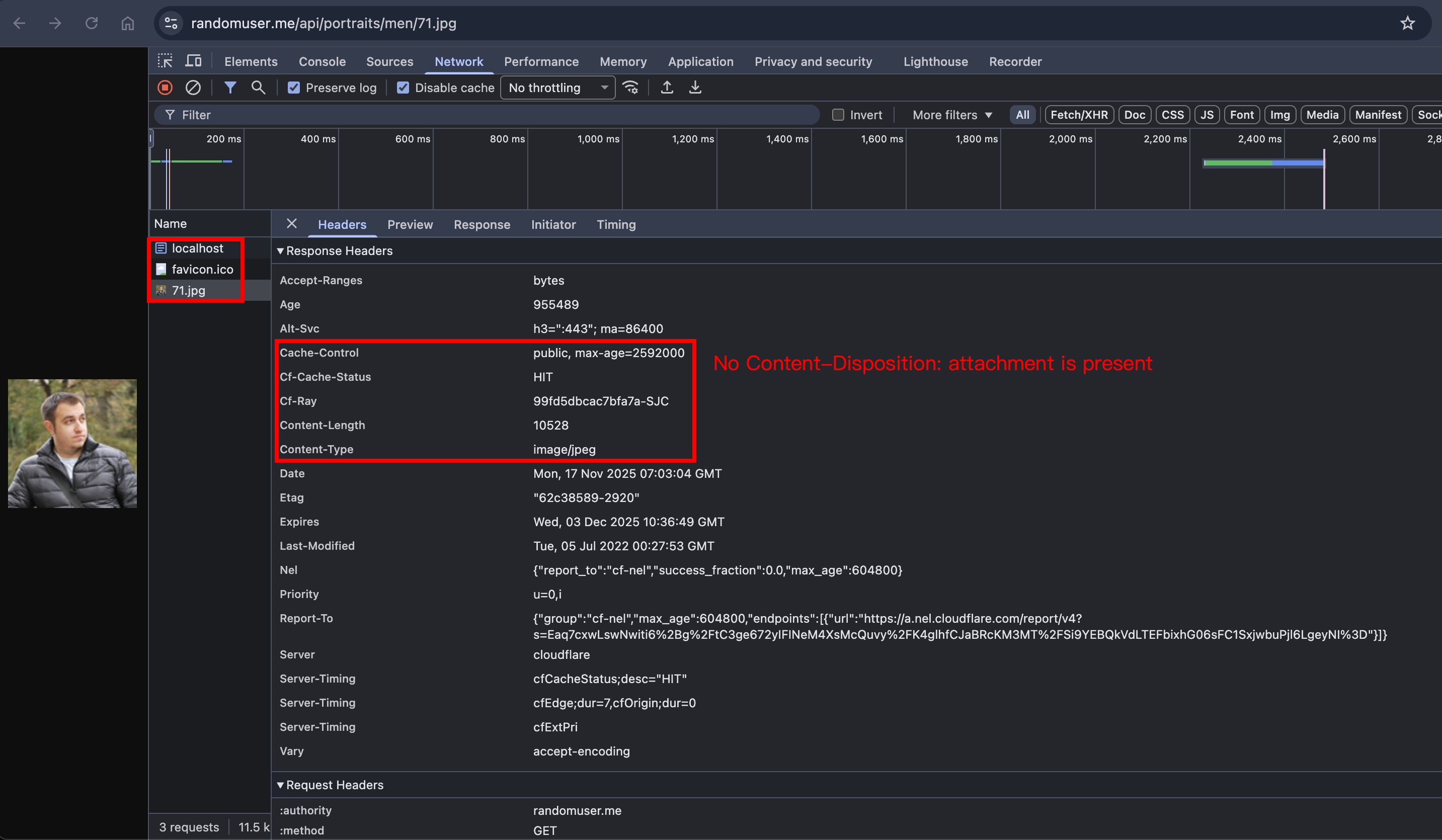
same-origin + no CD + <a download>
若改成 same-origin,就可以下載了嗎?寫個 PoC 實測看看
import httpServer from "../httpServer";
import { readFileSync } from "fs";
import { join } from "path";
const image = readFileSync(join(__dirname, "image.jpg"));
httpServer.on("request", function requestListener(req, res) {
if (req.url === "/image") {
res.setHeader("Content-Type", "image/jpeg");
res.end(image);
return;
}
if (req.url === "/") {
res.end('<a href="/image" download>download</a>');
return;
}
});
成功下載,不過 F12 > Network 並沒有顯示 HTTP Request
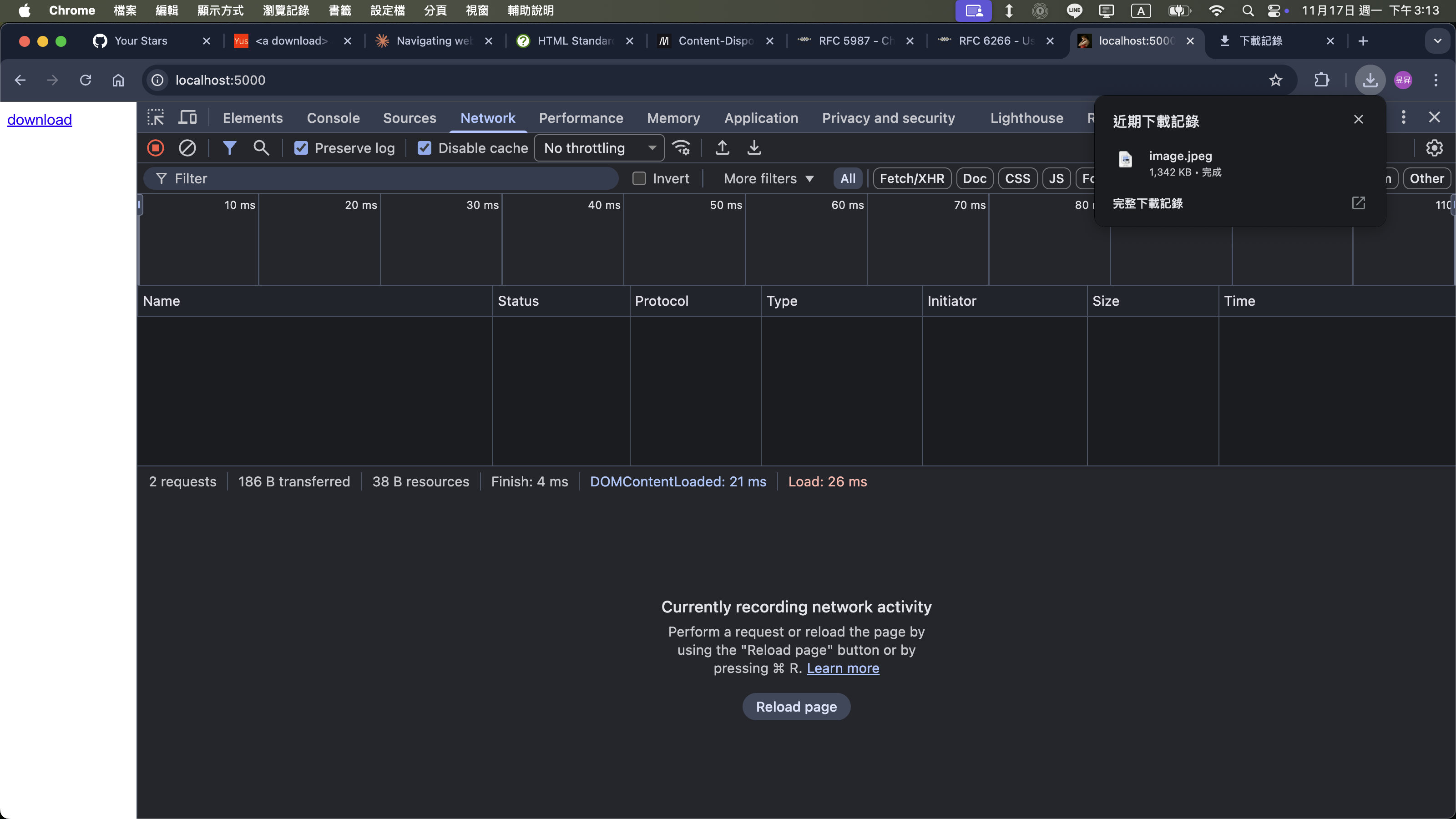
矛盾大對決1: same-origin + inline vs <a download>
PoC
import httpServer from "../httpServer";
import { readFileSync } from "fs";
import { join } from "path";
import { faviconListener } from "../listeners/faviconListener";
const image = readFileSync(join(__dirname, "image.jpg"));
httpServer.on("request", function requestListener(req, res) {
if (req.url === "/image") {
res.setHeader("Content-Type", "image/jpeg");
res.setHeader("Content-Disposition", "inline");
res.end(image);
return;
}
if (req.url === "/") {
res.setHeader("Content-Type", "text/html");
res.end('<a href="/image" download>download</a>');
return;
}
});
結果同 same-origin + no CD + <a download>
矛盾大對決2: cross-origin + attachment vs <a>
我們需要啟動兩個 http server,才能達成 cross-origin
PoC
import httpServer from "../httpServer";
import { readFileSync } from "fs";
import { join } from "path";
import { createServer } from "http";
import { faviconListener } from "../listeners/faviconListener";
const image = readFileSync(join(__dirname, "image.jpg"));
httpServer.on("request", function requestListener(req, res) {
if (req.url === "/image") {
res.setHeader("Content-Type", "image/jpeg");
res.setHeader("Content-Disposition", "attachment; filename=image.jpg");
res.end(image);
return;
}
});
const http5001Server = createServer().listen(5001);
http5001Server.on("request", (req, res) => {
res.setHeader("content-type", "text/html");
res.end('<a href="http://localhost:5000/image" download>download</a>');
return;
});
瀏覽器打開 http://localhost:5001/ ,點選 download 後,成功下載,並且 F12 > Network 有顯示 HTTP Request
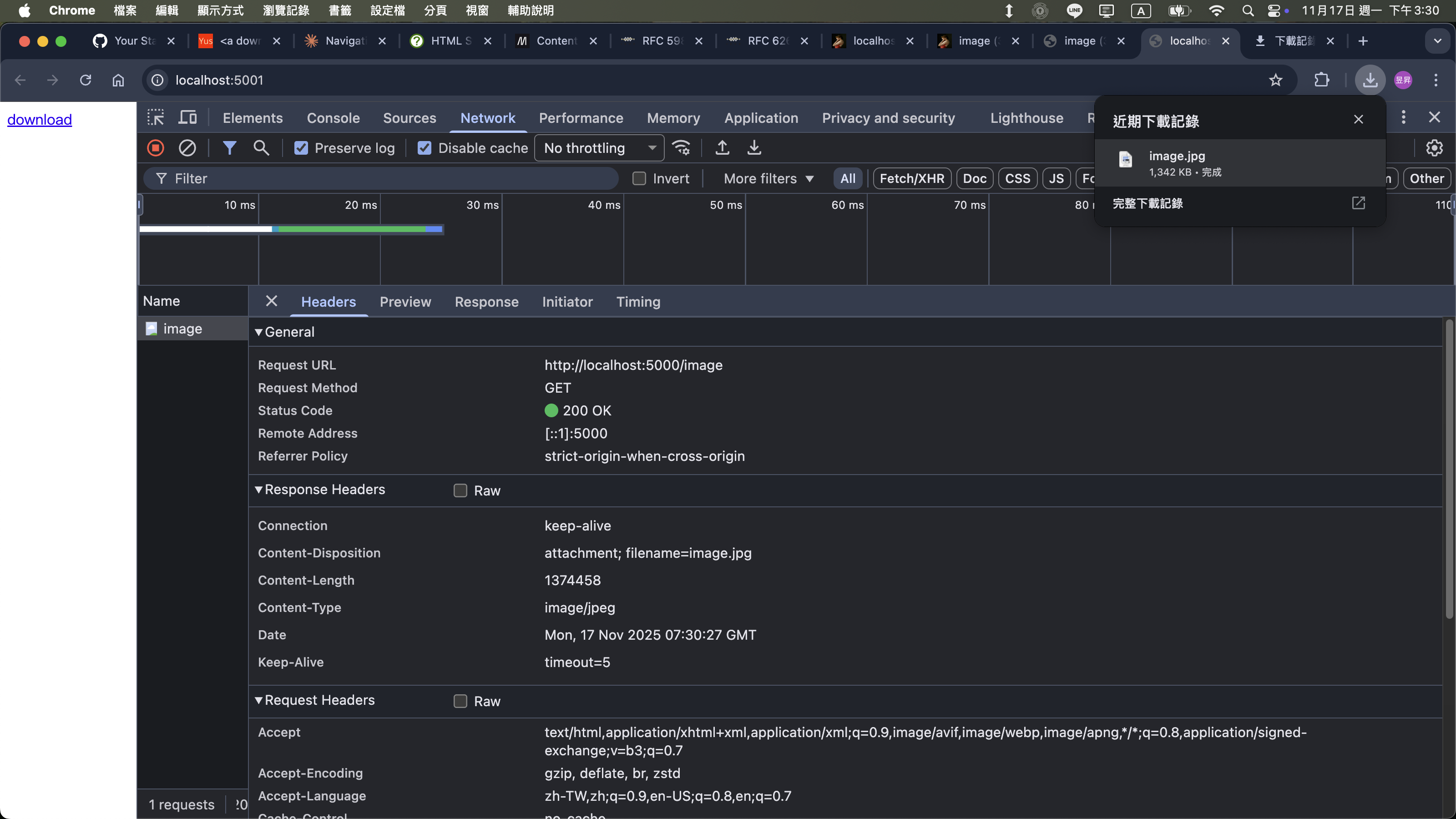
edge case1: cross-origin + attachment + Larger CL + <a download>
通常各種 HTTP Agent 都會自動計算 HTTP Request/Response 的 Content-Length,如果我們刻意設定一個 Larger CL,瀏覽器會怎麼處理呢?
PoC
httpServer.on("request", function requestListener(req, res) {
console.log(req.url);
if (req.url === "/test") {
// attachment + Larger CL + `<a download>`
res.setHeader("Content-Type", "text/html");
res.setHeader("Content-Disposition", "attachment; filename=test.html");
res.setHeader("Content-Length", 100);
res.end("Only11Chars");
return;
}
if (req.url === "/") {
res.setHeader("Content-Type", "text/html");
res.end('<a href="/test" download>download</a>');
return;
}
});
const http5001Server = createServer().listen(5001);
http5001Server.on("request", (req, res) => {
res.setHeader("content-type", "text/html");
res.end('<a href="http://localhost:5000/test" download>download</a>');
});
瀏覽器打開 http://localhost:5001/ ,點選 download 後,會顯示 "無法完成下載作業"

並且 Chrome 瀏覽器會自動 retry,看 NodeJS log 的話,會發現總共 retry 5 次
/test
/test
/test
/test
/test
/test
/test
edge case2: cross-origin + attachment + Smaller CL + <a download>
承上述案例,如果設定一個 Smaller CL,那檔案內容會被截斷嗎?
PoC 與上面相同,只有改動這行
res.setHeader("Content-Length", 10);
實測後,確實被截斷了
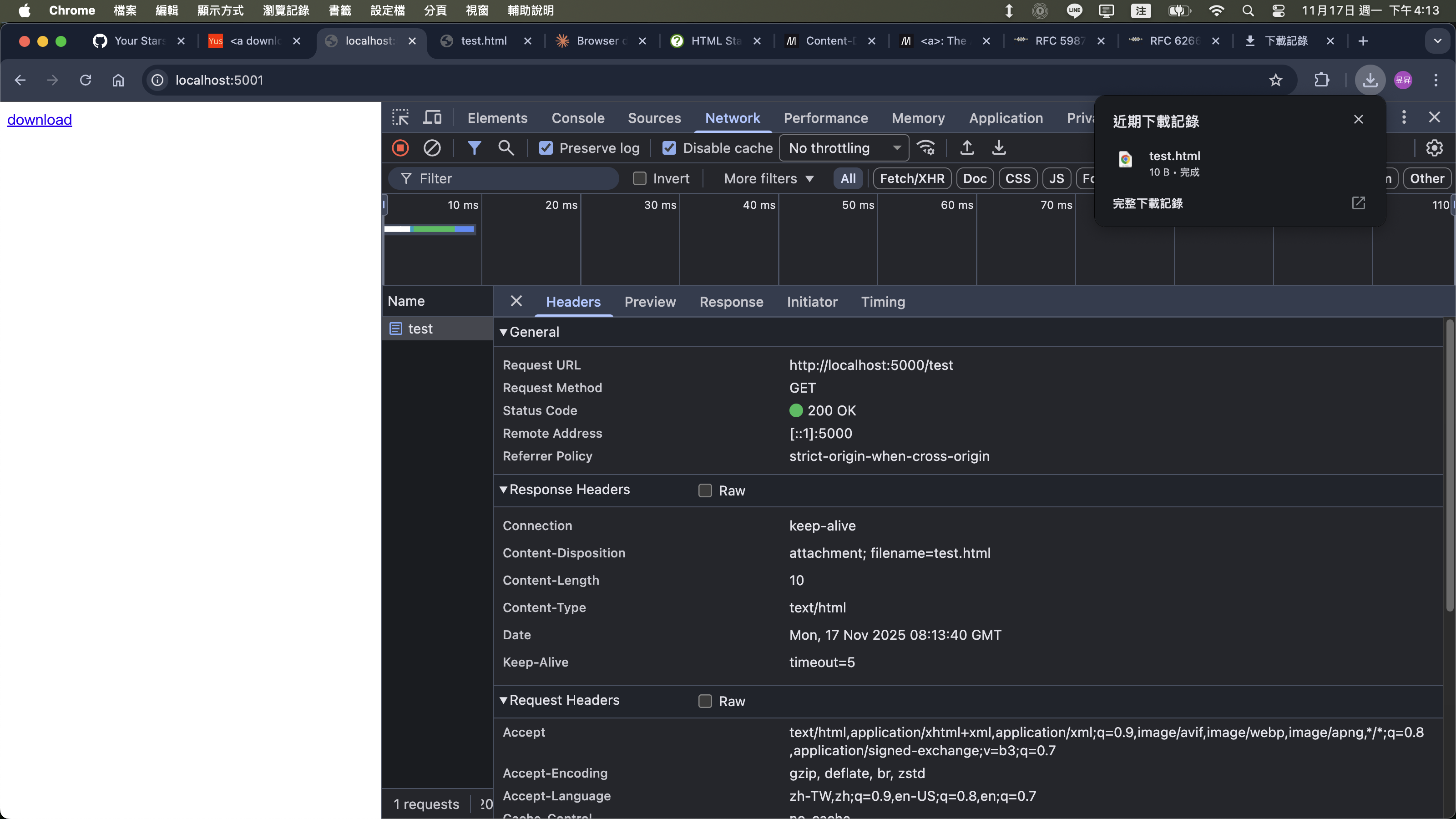
edge case3: cross-origin + attachment + 404 + <a download>
僅列出調整部分
if (req.url === "/test") {
res.statusCode = 404;
res.setHeader("Content-Type", "text/html");
res.setHeader("Content-Disposition", "attachment; filename=test.html");
res.end("Only11Chars");
return;
}
實測後,Chrome 直接把 Content-Length 跟對應的 Response Body 都拔掉了
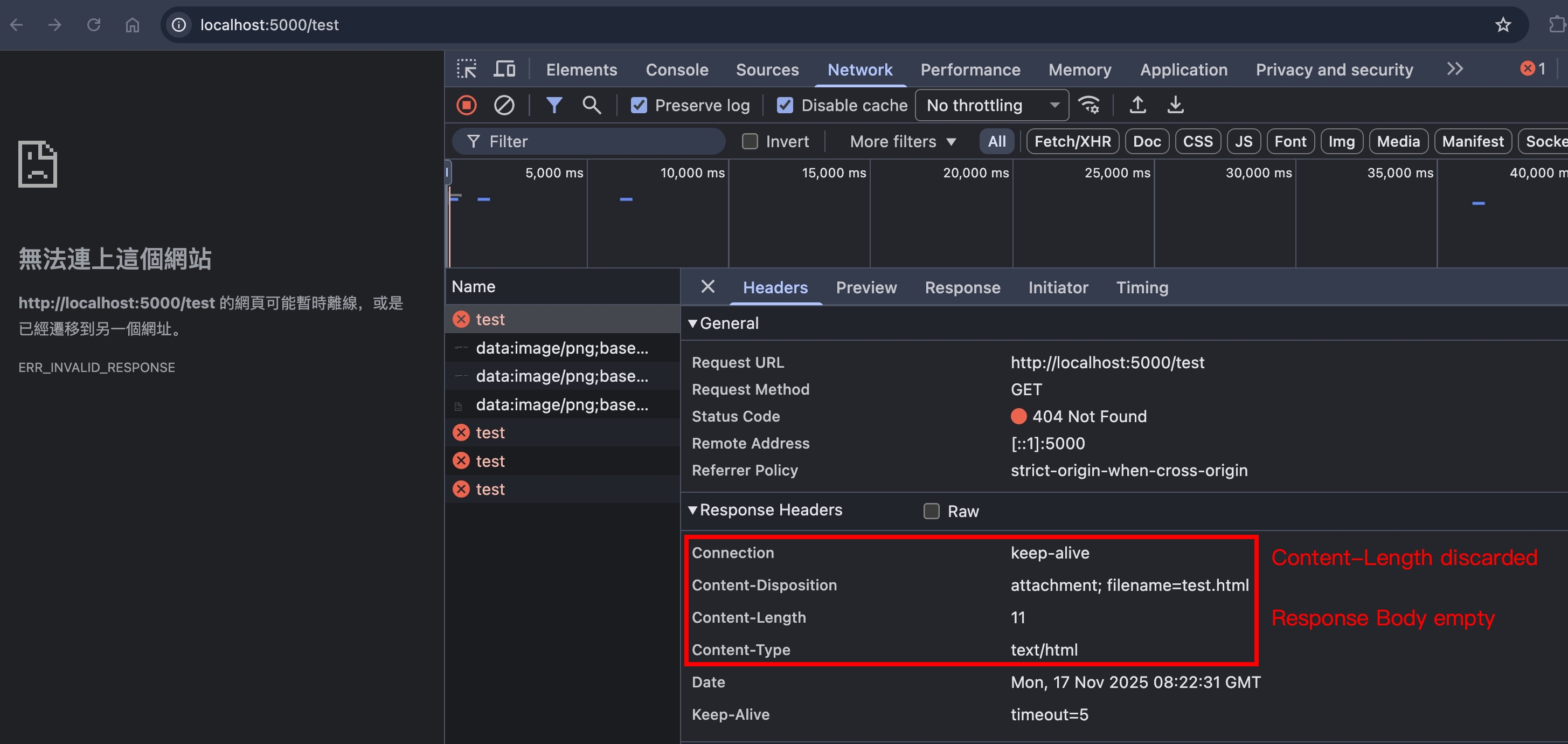
filename charset
範例
Content-Disposition: attachment; filename=filename.jpg
Content-Disposition: attachment; filename="file name.jpg"
Content-Disposition: attachment; filename*=UTF-8''file%20name.jpg
概念
- filename 預設的 charset 是 ISO-8859-1,也就是 ASCII 定義的 0 ~ 127,再擴展到 128 ~ 255 對應的歐洲字元
- 若 filename 有包含特殊字元,則需要用雙引號包起來
- 若 filename 有包含 ISO-8859-1 以外的字元,則可以用
filename*=UTF-8''URL-Encoded-Value的格式
實務建議
根據 RFC6266 section-5 的範例,建議兩者同時設定,確保向後兼容性
Content-Disposition: attachment; filename="EURO rates"; filename*=utf-8''%e2%82%ac%20rates
而 RFC6266 的原文是這樣說的
when both "filename" and "filename*" are present in a single header field value, recipients SHOULD pick "filename*" and ignore "filename"
實測環節 - edge case 1: filename=中文.jpg
PoC
res.setHeader("Content-Type", "image/jpeg");
res.setHeader("Content-Disposition", "attachment; filename=中文.jpg");
res.end(image);
return;
瀏覽器打開 http://localhost:5001/ ,點選 download 後,會顯示 "ERR_CONNECTION_REFUSED",查看 NodeJS log
TypeError: Invalid character in header content ["Content-Disposition"]
at ServerResponse.setHeader (node:_http_outgoing:702:3)
at Server.requestListener (/PATH/TO/YOUR/index.ts:49:9)
at Server.emit (node:events:518:28)
at Server.emit (node:domain:489:12)
at parserOnIncoming (node:_http_server:1153:12)
at HTTPParser.parserOnHeadersComplete (node:_http_common:117:17) {
code: 'ERR_INVALID_CHAR'
}
看來 NodeJS http 模組有遵守某個 RFC 規範 (?)有時候想要測試 malformed HTTP Request/Response,用各個程式語言封裝好的 http 模組,都會被限制,這時候就得用底層一點的模組來控制;以 NodeJS 為例,可以使用 net.Socket 來控制 raw HTTP Response,如果還不熟悉的夥伴們,可以參考我去年寫過的
PoC
res.socket?.write(`HTTP/1.1 200 Ok\r\n`);
res.socket?.write(`Content-Length: ${Buffer.byteLength(image)}\r\n`);
res.socket?.write(`Content-Disposition: attachment; filename=中文.jpg\r\n`);
res.socket?.write(`Content-Type: image/jpeg\r\n\r\n`);
res.socket?.end(image);
實測後,檔名在作業系統有正確呈現

但 F12 > Network 呈現的檔名是錯的(?)
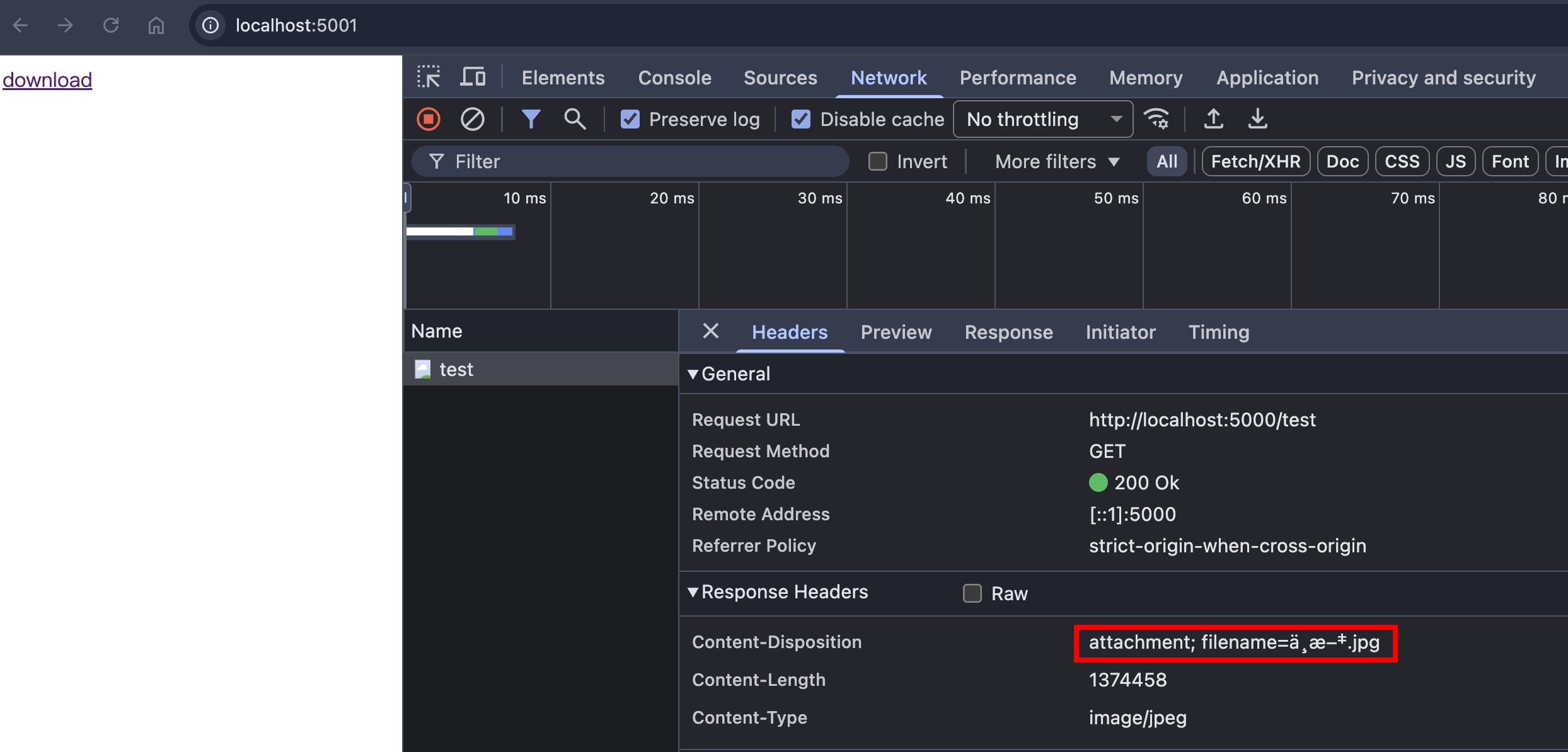
嘗試用 curl -v "http://localhost:5000/test" --output test.jpg,確保上面的 PoC 是正確的
* Request completely sent off
< HTTP/1.1 200 Ok
< Content-Length: 1374458
< Content-Disposition: attachment; filename=中文.jpg
< Content-Type: image/jpeg
wc -c test.jpg 確認 Content-Length 符合
1374458 test.jpg
至於 ä¸æ–‡.jpg 是什麼呢?這其實是編碼轉換的問題,瀏覽器看到 filename=,預設用 ISO-8859-1 的編碼來呈現,轉換過程為:
| UTF-8 | Hex | ISO-8859-1 |
|---|---|---|
| 中文 | e4 b8 ad e6 96 87 | ä¸æ–‡.jpg |
嘗試用最小 PoC 來驗證
if (req.url === "/ISO-8859-1") {
const buffer = Buffer.from("中文", "utf8");
res.setHeader("Content-Type", "text/html; charset=iso-8859-1");
res.setHeader("Content-Length", buffer.byteLength);
res.flushHeaders();
res.socket?.end(buffer);
return;
}
瀏覽器訪問 http://localhost:5000/ISO-8859-1 ,可以正確看到 ä¸æ–‡ 了~
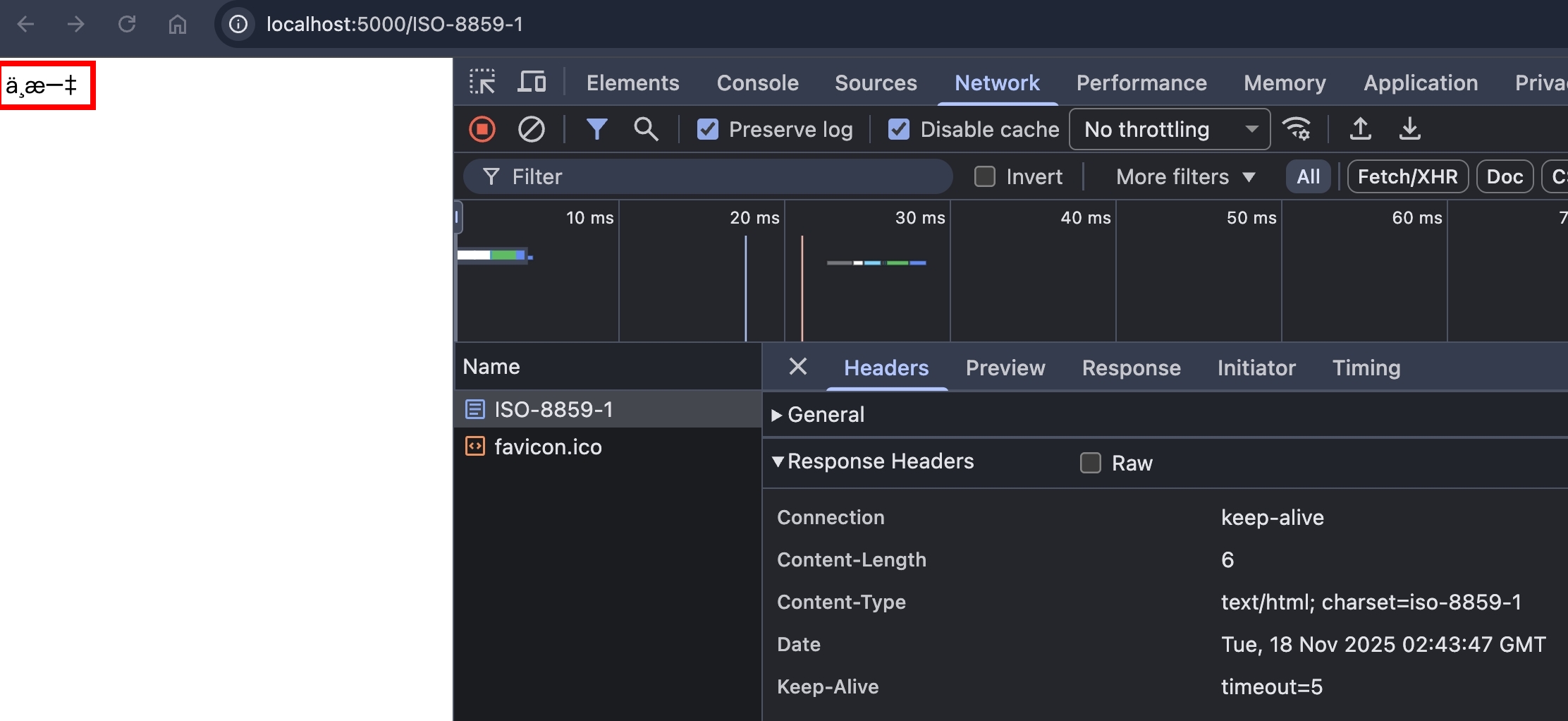
P.S. 現在很多網站,工具預設都用 UTF-8,所以創建一個 Content-Type: text/html; charset=iso-8859-1 的網頁來測試,會比較準確
實測環節 - edge case 2: filename=hello world.jpg
PoC
res.setHeader("Content-Type", "image/jpeg");
res.setHeader("Content-Disposition", "attachment; filename=hello world.jpg");
res.end(image);
return;
實測後,檔名有正確呈現在 F12 > Network 跟作業系統
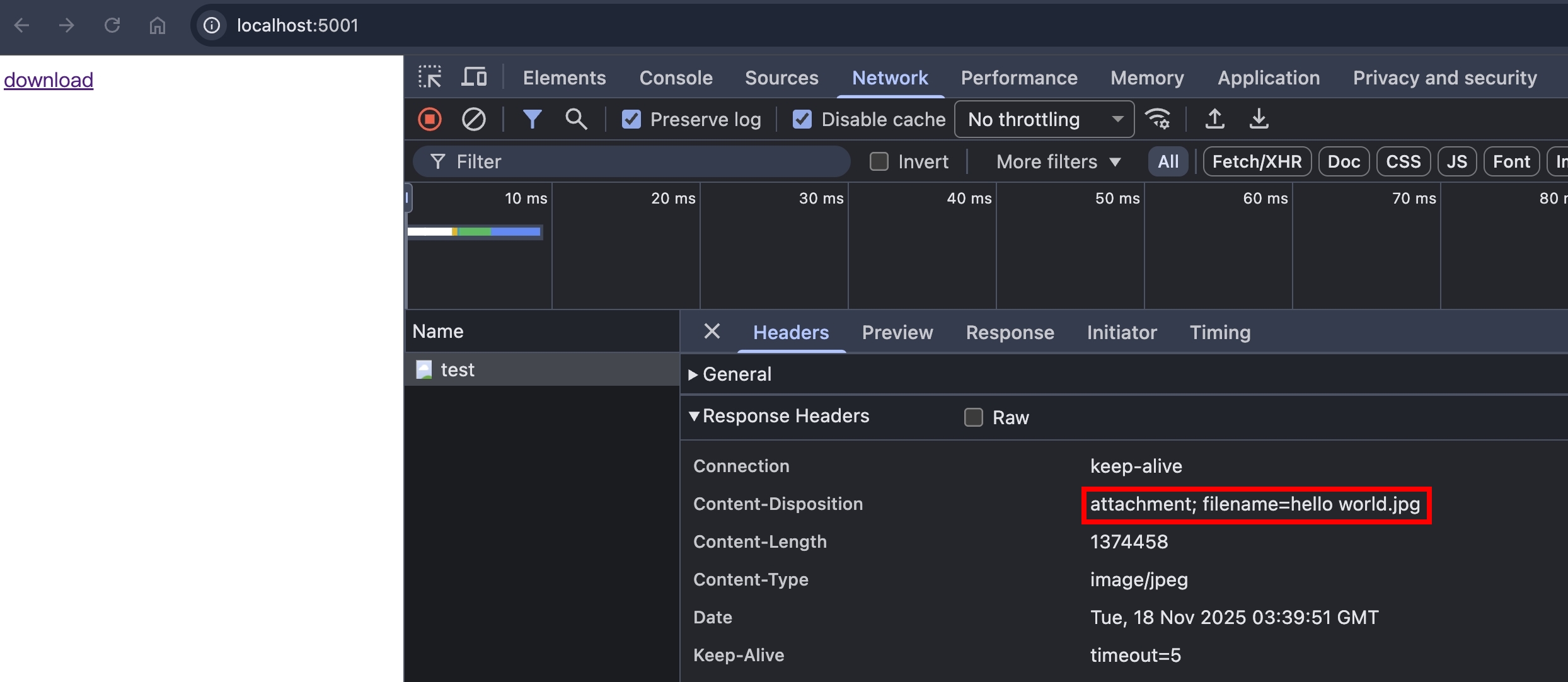

實測環節 - edge case 3: filename=hello%0D%0Aworld.jpg
P.S. %0D%0A 是 CRLF 的 URLEncode 版本
PoC
res.setHeader("Content-Type", "image/jpeg");
res.setHeader(
"Content-Disposition",
"attachment; filename=hello%0D%0Aworld.jpg",
);
res.end(image);
return;
實測後,檔名有正確呈現在 F12 > Network,但下載到作業系統後,%0D%0A 被轉換成 __
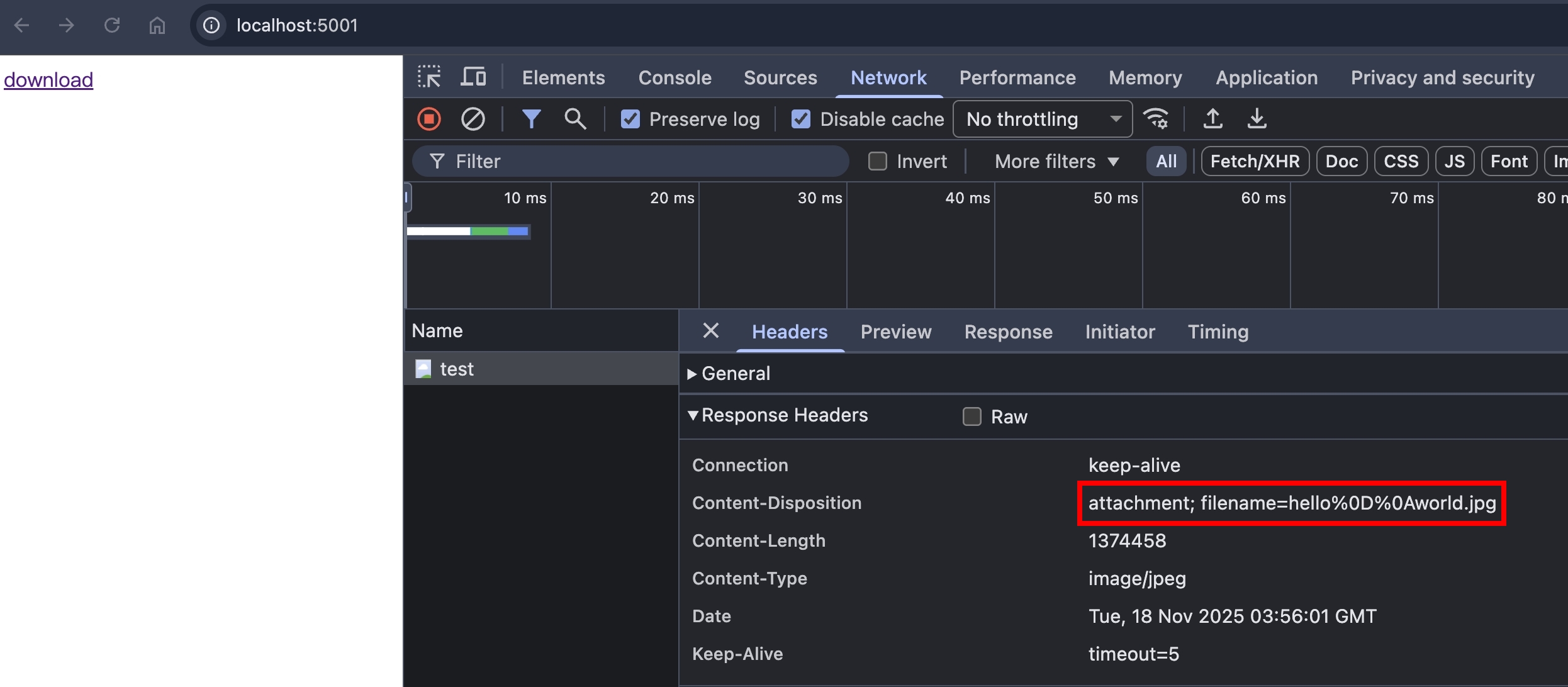

根據 MDN 文件的描述
Browsers may apply transformations to conform to the file system requirements, such as converting path separators (/ and \) to underscores (_).
瀏覽器這樣做,除了正規化檔名,讓各個作業系統的 file system 可以正確呈現,還可以避免 Path Traversal
小結
這個章節,我們學到了
<a download>跟Content-Disposition的交互情境- filename 的 charset
- 如何正確在瀏覽器呈現 ISO-8859-1 的文字